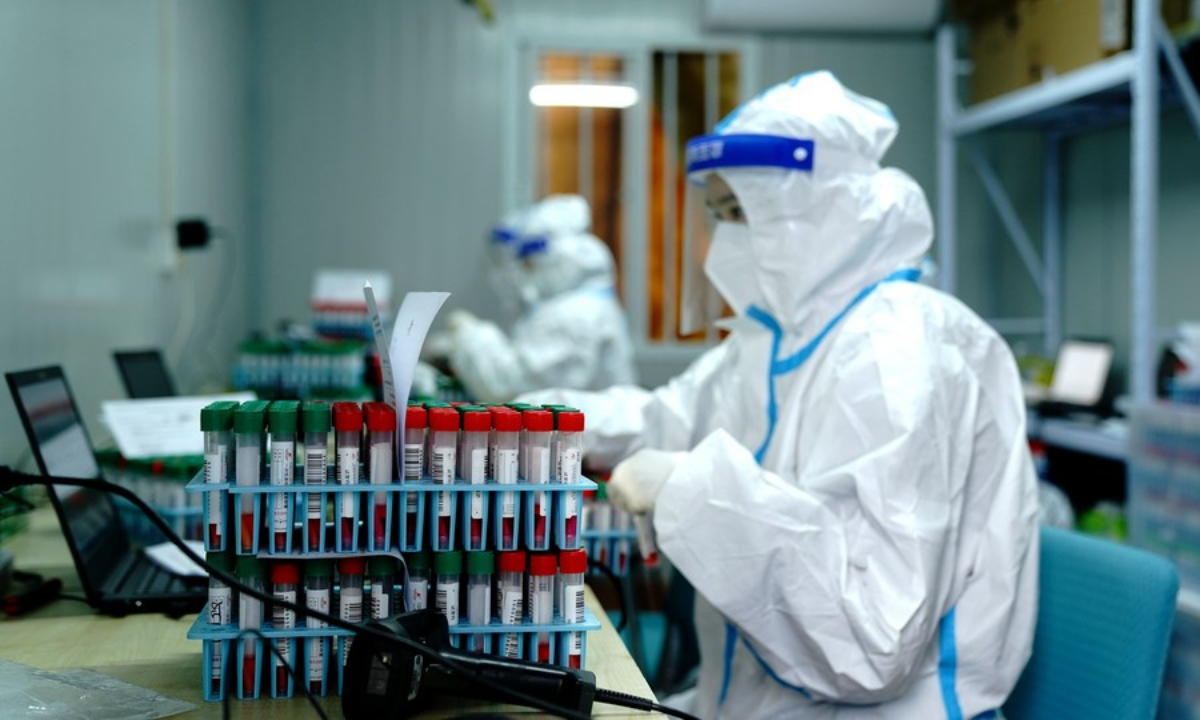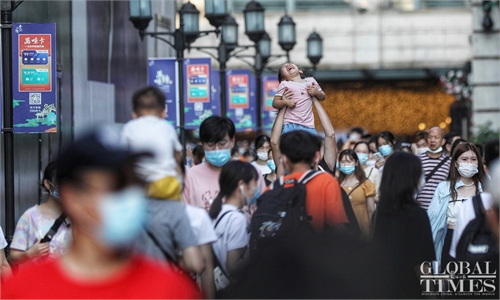Second wave of massive COVID outbreak ‘less likely,’ say experts amid public concerns before May Day holidays

Medical workers work in a COVID-19 testing lab in east China's Shanghai, April 15, 2022. Photo:Xinhua
A few months have passed since China encountered its first wave of a nationwide Omicron outbreak. Now more and more Chinese netizens have started to express concerns over a second wave as the country is preparing for upcoming May Day holidays while a new COVID-19 variant is reported to have swept about 30 countries and regions.
It is still hard to predict a precise timing for the second wave, experts said, stressing vaccination and physical protection, given the risk of imported variants along with the gradual reopening of the country's borders and booming domestic travel in the upcoming holidays.
Reports of cases caused by the new variant XBB.1.16 being detected in China spread widely on Chinese social media on Tuesday. The variant had reportedly swept about 29 countries and regions at a faster speed and would lead to conjunctivitis.
This has triggered growing concerns among Chinese netizens over a second wave of Omicron striking when the country is excitingly waiting for the busy and prosperous May Day holidays from April 29 to May 3.
Speculation about when China will experience a second wave of COVID-19 outbreaks has been widely discussed. But COVID predictions are a complex issue by nature, as they involve variables including the features of the virus, immunity barriers and population behavior, meaning they can hardly be precisely calculated, Zhuang Shilihe, a Guangzhou-based immunologist, told the Global Times on Tuesday.
A prevailing view believes China will not witness a second wave months after the first wave since late 2022, but the problem is how many months, Zhuang said.
He tried to ease public concerns by explaining that conjunctivitis is not a new symptom brought about by XBB.1.16, but one that was seen among COVID-19 patients as early as in the initial stage of the pandemic, citing documents released by China CDC.
China witnessed a slight increase in the COVID-19 positivity rate in early April from 0.7 percent on March 30 to 1.4 percent on April 6, according to a recent report released by the Chinese Center for Disease Control and Prevention (China CDC). But respiratory specialists noted that China is unlikely to see another wave of large-scale COVID-19 infections.
Across the world, the COVID-19 pandemic is approaching an end, Wu Zunyou, chief epidemiologist of the China CDC, noted at a forum on April 13, citing data released by the World Health Organization (WHO). Wu said that the threat of COVID-19 infection is no longer that serious, according to the Beijing News.
According to the WHO's weekly report released on April 13, 3 million new cases and more than 23,000 deaths were reported globally from March 13 to April 9, decreases of 28 percent and 30 percent compared with the previous 28 days.
As of April 9, more than 762 million confirmed cases and 6.8 million deaths had been reported globally, the WHO said.
In the future, the COVID-19 virus will probably only cause outbreaks in certain areas and during certain periods, but science still lacks research on the frequency of this matter, Dai Lianpan, a researcher at the Chinese Academy of Sciences, told the Science and Technology Daily on Monday.
Given the unclear knowledge of the virus, Dai noted that vaccination is still the most effective and economical way to prevent infection.
To protect people from new Omicron variants, Dai called on those who had not completed inoculation but had been infected during the first wave to take vaccines to boost the immune effect.
Experts remind people to use physical protection, keep daily hygiene rules and wear masks in crowded places given the risk of imported variants with the gradual reopening of the country's borders and the booming domestic travel in the upcoming holidays.
To effectively deal with the recent situation, China's National Health Commission updated its inoculation plan on April 10, saying that adults could take a shot of vaccine three months after they finished basic immunization or were infected. The interval was six months previously.
A domestic mRNA vaccine will be put into emergency use to enhance the immunization of the public, according to the latest plan.
Chinese vaccine manufacturers are continuing research to develop new vaccines that can prevent new variants. Tianjin-based CanSinoBIO announced on Monday that its bivalent mRNA COVID-19 vaccine had been approved for clinical trials by related authorities.
China's disease prevention and control mechanism and system have also improved a lot during the three years' fight against the epidemic. For example, the country isolated the antigen and decoded the genetic sequence of the virus within one week. It also set up a nationwide real-time monitoring and reporting system, Wu noted at the forum.
Besides, the country is preparing to build a national data bureau to make it possible for hospitals and relevant authorities to share data promptly. These experiences and measures would help China better deal with public health emergencies in the future, according to Wu.



